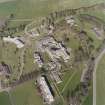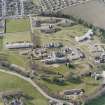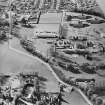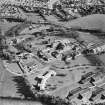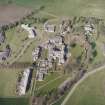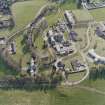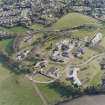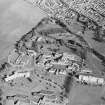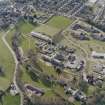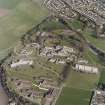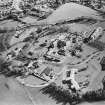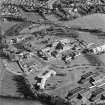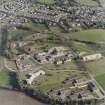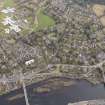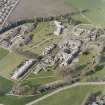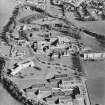Following the launch of trove.scot in February 2025 we are now planning the retiral of some of our webservices. Canmore will be switched off on 24th June 2025. Information about the closure can be found on the HES website: Retiral of HES web services | Historic Environment Scotland
Perth, Bridgend, Murray Royal Hospital
Psychiatric Hospital (19th Century)
Site Name Perth, Bridgend, Murray Royal Hospital
Classification Psychiatric Hospital (19th Century)
Alternative Name(s) Kinnoull, Murray Royal Asylum
Canmore ID 127579
Site Number NO12SW 335
NGR NO 1293 2403
NGR Description Centred NO 1293 2403
Datum OSGB36 - NGR
Permalink http://canmore.org.uk/site/127579
- Council Perth And Kinross
- Parish Kinnoull
- Former Region Tayside
- Former District Perth And Kinross
- Former County Perthshire
NO12SW 335.00 centred 1293 2403
NO12SW 335.01 NO 12890 24077 Chapel
NO12SW 335.02 NO 12929 23988 Main Block
For archaeological finds from the area of the hospital, see NO12SW 3, NO12SW 66 and NO12SW 76.
Architect: William Burn 1827
Standing Building Recording (22 February 2021 - 1 March 2021)
NO 12879 24062–NO 13113 24009 A historic building survey was carried out from 22 February–1 March 2021, of a number of late 19th- and early 20th-century hospital buildings comprising the former Murray Royal Hospital complex in Perth, prior to the part-demolition and renovation of the buildings. The work was required as a condition of the listed building consent on the development, and included both a basic and enhanced level of historic building survey on the buildings, which included the main Murray Royal Hospital, the Birnam and Elcho Villas, Chapel and Gilgal Building.
The Murray Royal Hospital was constructed in the early 1820s to designs by architect William Burn and was later extended to the NW side in 1833. It was constructed as a lunatic asylum for the people of Perth and the surrounding districts under the will of James Murray of Tarsappie. After the 1830s extensions, it comprised a typical H-Plan hospital with a central administration wing with wards for female and male inpatients to the SW and SE sides, with additional wards to the NW added in 1889. In 1903–1904, two identical detached villas were constructed to the NW of the hospital – the Elcho and Birnam Wings – together with a small chapel between them. At the same time, a sub-basement walkway was also created between the Chapel and the main hospital building. In the early 1930s, another larger detached building known as the Gilgal Building was constructed further to the SE of the hospital for voluntary inpatients.
The layout of the main hospital building is defined by its
large circulation area to the SE side of its central wing, which is located below an octagonal tower rising above the roof with a glazed cupola added in the 1850s. Decorative wrought iron railings adorn the upper second and attic floor levels creating a walkway. There are some late 19th-/early 20th-century detailing in the building, such as the timber panelled doors, cornices and decorative ceilings, together with some survival of cast- iron fireplaces. However, the more elaborately decorated rooms in the building are located at the second floor level in the NW side, consisting of a library with fine joinery and timber detail, and a ballroom. Both rooms have been subject to severe damp and mould in recent years, although much of their original character has been retained.
The Elcho and Birnam Wings are virtually identical and
in opposite symmetry built in an Arts and Craft style with a half-timbered first floor. The Chapel, located between these buildings, has a Nave and Sacristy to the NW side with a small basement area. The Chapel was designed by A R Urquhart in a Scots Gothic style with a plain pitched slate roof and tower at the SE font. This, and the adjacent villas, were all built on a large elevated piece of land with an uninterrupted view of the landscape.
The Gilgal building was constructed in 1930 and designed by architects Smart, Stewart and Mitchell as a detached hospital to the SE of the main hospital building for voluntary inpatients. From the 1990s, a new hospital complex was erected to the NW of the older hospital which eventually became derelict.
In the last few years, the main building has been subject to roof material theft which has led to a severe damp problem in many areas of the building. A fire also gutted the Gilgal building in 2011, which meant that the interior of that building was inaccessible at the time of survey due to health and safety concerns.
Archive: NRHE (intended) Funder: Riverside Residential
Diana Sproat – AOC Archaeology Group
(Source: DES Vol 22)
OASIS ID: aocarcha1-419260
Photographic Survey (26 May 2021)
The main building of the Murray Royal Hospital was recorded as part of the Threatened Buildings Survey on 26th May 2021 prior to its proposed conversion into residential apartments.
The Murray Royal Hospital was designed in 1821 by William Burn and opened in 1828. A severe neo-classical building of coursed sandstone with advanced centre and end bays with a central Doric entrance porch. It is the earliest surviving asylum building in Scotland. There were other, earlier asylums built: Montrose was the first in 1782, followed by Aberdeen (1800), Glasgow (1807), Dundee (1812) and Edinburgh (1813). These buildings have all been demolished.
The original building T-plan consisted of a central block containing the octagonal hall, staircase and separate accommodation for the superintendent and the matron. This was flanked by two wings containing self-contained accommodation for male patients on one side and females on the other. William Burn extended the north wing in 1833 creating an H-plan building. After a fire in the upper floors in 1837 William Burn returned and made the building more fireproof. In 1865 further improvements were made including the ‘removal of the dark staircase opposite the entrance’ and the addition of the cupola over the octagonal hall creating the distinctive ‘birdcage’ hall. In 1888 Andrew Heiton Junior of Perth added wings to the north range. He also filled in the north facing galleries creating the ballroom and other recreational spaces. He also added the glazed veranda along the north wall of the north wing.
The James Murray bequest that originally funded the Murray Royal Hospital came from the proceeds of wealth created overseas through Scotland’s Colonial enterprise.




























































